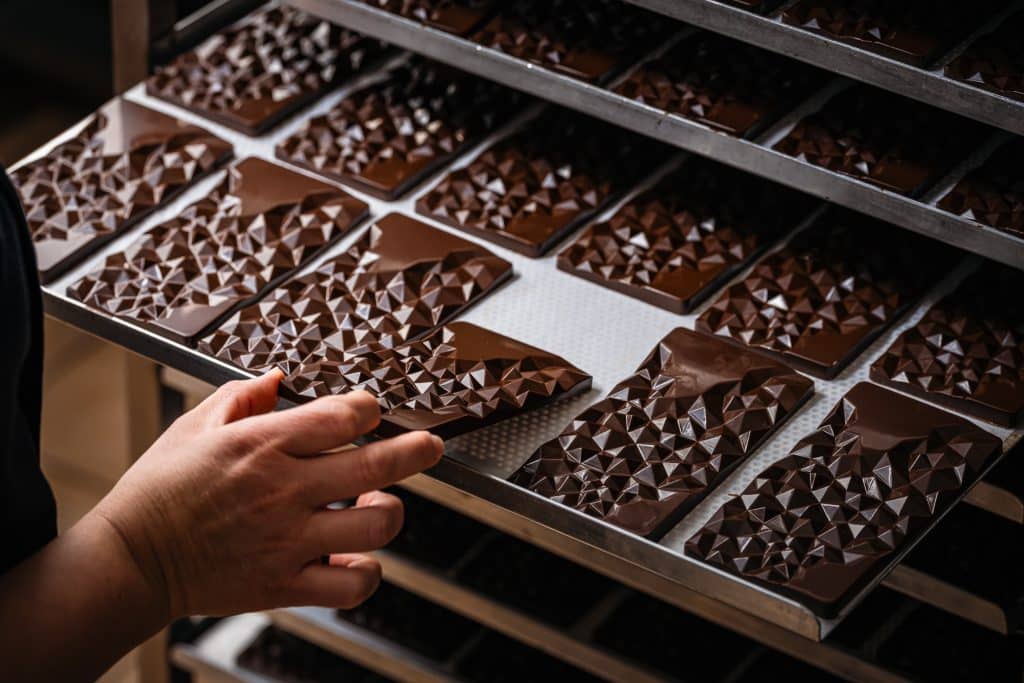A coffee-based delicacy from Geneva offers a chocolate variant

It may have the same colour and texture, but Coffola® mass is not made from cocoa beans, but from coffee beans.
Some 25 tonnes are produced every year in Meyrin (GE). Marc-André Cartier and Léa Provenza have invented a way of making coffee 100% edible. The first step is to grind the beans, then work the mass as you would with chocolate.
The aromas wafting around the premises leave no doubt as to the main ingredient used by Marc-André Cartier and his team: freshly roasted coffee. However, looking at the bars spread out on the stainless steel work surface of the Coffolaterie laboratory in Meyrin (GE), you’d think it was chocolate. The appearance is identical, from the colour to the texture. You’ll have to wait until you taste it to discover the difference and grasp the novelty of this speciality. ‘With Coffola, we’ve invented a way of making 100% of the coffee edible, so there’s no waste,’ says manager Marc-André Cartier.
While the raw materials are, unsurprisingly, imported – they use great vintages from Colombia, Kenya and Ethiopia – the Genevans work with a local roaster, Carasso. Roasting plays a vital role in the flavour of our product,’ says the artisan, pointing to the jute sacks on a shelf in the laboratory. It took time and advice from coffee specialists for us to find perfectly roasted beans. They must not simply be heated, but quickly cooled at the end of the process. If they were burnt, the Coffola would simply be inedible.
Crushed for four hours
Two large steel machines make a deafening noise: 400 kg of metal balls crush 60 kg of coffee bean mass. ‘Coffee beans are harder than cocoa beans, because they contain less fat, so we had to find a tool adapted to this particularity. The equipment we use is inspired by the cosmetics industry’.
Once ground, the beans are placed in the machine, where cocoa butter, sugar and milk powder are added. Over a period of four hours, the ingredients are crushed and mixed while being gradually heated. ‘We then check the fineness of the product. We aim for particles of no more than 15 microns, as opposed to 18 microns for chocolate,’ explains Marc-André Cartier, as he spreads the paste out on a metal ruler in a gesture repeated a thousand times.
At the end of these stages, the mass is ready to be worked in the same way as chocolate. Today, Marc-André Cartier and Léa Provenza are making small almond rochers covered in Coffola. Further on, rectangles are delicately placed on biscuits. The various uses to which the product has been put by ice-cream makers and bakers demonstrate its full potential: from fragments incorporated into stracciatella ice-cream, to a bar slipped into croissants, to a combination, in the form of a ganache, with the sweetness of a macaroon. One of the arguments that has won over the professionals is the fact that there are only four ingredients,’ says Marc-André Cartier. There are no colourings, preservatives or additives. Only the essential ingredients are used, and this reduced list means that the product can be fully traced’.
Several variations
What about the general public? Anyone can use Coffola in recipes or simply enjoy the products the company sells: pure or milk-based bars, Piedmont hazelnut spread, coated hazelnuts or chewy bars, there’s an embarrassment of riches to choose from. What’s more, the team has no intention of stopping there: the company will soon be offering vegan products based on oat milk, while the entire production process will be certified organic in the medium term.
To make a name for itself, the speciality of Marc-André Cartier and his team has gradually found its way onto the shelves of organic retailers, as well as into luxury grocery shops in French-speaking Switzerland. ‘For customers to understand that our product is not just another chocolate bar on the market, Coffola has to be presented and explained by the staff. On the palate, an explosion of coffee immediately makes you forget its resemblance to chocolate. A successful gamble, this product has everything it takes to become a new favourite.
A MINI-DOSE OF CAFFEINE
Is eating a square of Coffola the same as drinking a whole cup of coffee? Given the intensity of the product, it’s easy to wonder how much caffeine it contains. Marc-André Cartier reassures us: ‘One bar contains the equivalent caffeine dose of one and a half coffees. But, as with chocolate, we don’t recommend eating a whole bar. Although Coffola has fewer calories than chocolate, our recipe still contains sugar’.
And if you do indulge in a Coffola bean, which is a perfect accompaniment to a small coffee, it’s only one twenty-second of a cup.
THE ARTISANS: MARC-ANDRÉ CARTIER AND LÉA PROVENZA
Years ago, chocolatier Marc-André Cartier tried to process coffee like cocoa beans, but without success. It took a great deal of tenacity and conviction to prove that the idea was feasible. After a year and a half of tests, an essential step in refining the recipe, the Coffolaterie story began. Based for two years in Meyrin (GE), the company has since been joined by chocolate-maker Léa Provenza.
The Coffolatiers, as they call themselves, already produce more than 25 tonnes a year, and are planning to quadruple that figure in the long term. Sales are split 50% between professionals and the general public.

